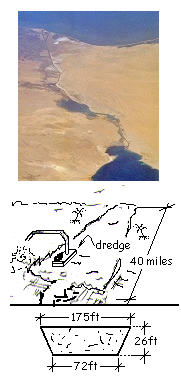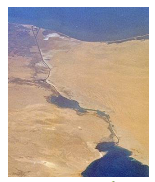| THERMO Spoken Here! ~ J. Pohl © | TOC NEXT ~ 220 |
Dig Suez

The Suez Canal was dug across 40 miles of desert by a team of dredges. The canal initiated in a lake at its north end. It was "dug" by pumping a water-saturated sand mix (slurry) from the canal to a bank about half a mile away. The average rate of sand removed by the digging machines was six million cubic feet per month. The figure shows a pictoral view of the completed canal and a sketch of the canal average profile.
Estimate the number of years required to dig the canal.
♦ Before digging began, surveyors staked out the canal profile in the sand. As our system we take the sand initially within the profile specified. As digging proceeds, that sand will be steadily removed from that original space. The mass equation is:

| (1)
The mass equation. |
The system mass equals its constant density times its diminishing volume. Assume no mass enters the canal by bank "slide-in" events or such. It is likely that sand will be removed at many locations as the digging is done. However, we assume there is one, very big dredge removing a rate of sand equal to the sum of all machines operating.

| (2)
Our system has one |
The system mass equals the density times the volume at any time. The mass exiting equals the sand density times the volume-rate of sand removed.

| (3)
Mass equals density times volume. Mass rate equals density time volume-rate. |
The above representations include that the density of the sand and volume rate of sand removal are constant. We substitute these identities into the mass equation to obtain the following differential equation.

| (4)
A first-order differential equation with system mass as the |
Solution of this differential equation (we seek the time required to dig the canal) follows as before. The first step is to separate its variables:

| (5)
This differential equation has its variables “separated.” |
Note: We might divide the above equation by the constant term, density. But then what would we have, a "volume equation?" Better to leave the mass equation as a "mass equation" until it is solved. The mass equation is relatively simple. This is a good habit to have. The momentum equation and energy equation have more terms. Maintain their terms as momentum or energy. Do things the same way to avoid errors.
Next we apply integration operators. The lower limits (both integrals) are associated with the initial state of the canal and the initial time of digging. By the calculation below we know the initial volume of sand the is 678 million cubic feet; this is the lower limit of the left-of-equality integral and the lower limit of the integral right-of-equality is the time, t = 0+.

| (6) The mass of sand to be removed. |
The upper limits of the integrals are associated with the final conditions of system properties and the ending time of digging. The final volume (the volume of sand in the canal once all sand has been removed) is zero. So the upper limit left-of-equality is zero cubic feet. And correspondingly the limit right-of-equality is the unknown time of finish. Place limits on the integrals:

| (7)
The mean value theorem of calculus is needed. |
The integral right-of-equality poses a problem because we don't know the time wise volume rate of the dredges. Maybe the dredges were broken down much of the time. Or fewer pumps might have operated to begin the dig and more were added later. There is no way for us to know. What to do?
To proceed we are going to do something that is done VERY OFTEN in thermodynamic and engineering analysis. We apply the Mean Value Theorem to the integral by using the number given as an average. We assume six million cubic feet per month as the average removal rate. Both integrals are of "exact differentials" now. These integrate promptly.

| (8)
The integrand of the exact differential is “1.” Fun to integrate these! |
Now divide the equation by the density. Make sure the units behave.

| (9)
Quite an engineering feat! Many lives were changed. |
This is about the actual time the digging required which means the "average digging rate" assumed was close to fact. This problem was "reverse-engineered" of course.

Dig Suez
The Suez Canal was dug across 40 miles of desert by a team of dredges. The canal initiated in a lake at its north end. It was "dug" by pumping a water-saturated sand mix (slurry) from the canal to a bank some half mile away. The average rate of sand removed by the digging machines was six million cubic feet per month. The sketch shows an average profile of the canal.
Estimate the years required to complete the digging of the canal.
Premise presently unwritted!